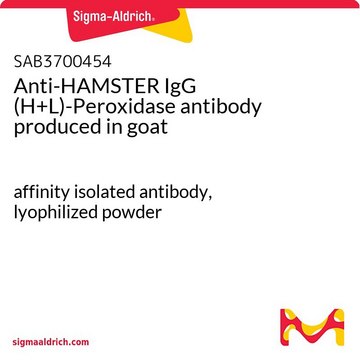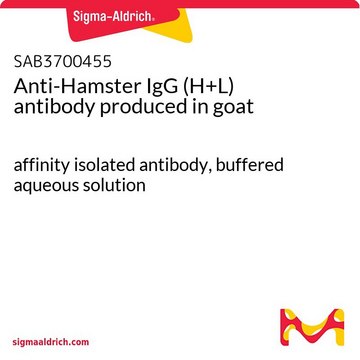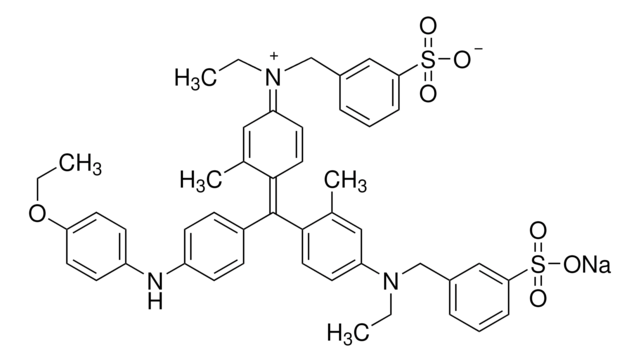H1643
Anti-Hamster IgG (whole molecule) antibody produced in rabbit
affinity isolated antibody, buffered aqueous solution
Autenticatiper visualizzare i prezzi riservati alla tua organizzazione & contrattuali
About This Item
Prodotti consigliati
Origine biologica
rabbit
Coniugato
unconjugated
Forma dell’anticorpo
affinity isolated antibody
Tipo di anticorpo
secondary antibodies
Clone
polyclonal
Stato
buffered aqueous solution
tecniche
indirect ELISA: 1:100,000
Condizioni di spedizione
dry ice
Temperatura di conservazione
−20°C
modifica post-traduzionali bersaglio
unmodified
Descrizione generale
IgG is present in large quantities in the human serum. IgG is composed of glycoproteins, out of which it is 82-96% proteins and 4-18% carbohydrates. It consists of four sub-classes i.e IgG1, IgG2, IgG3, and IgG4. IgG is composed of four polypeptide chains-two heavy chains (γ chains) and two light chains (κ or λ chains) which are linked by inter-chain disulfide bonds. The heavy chains consist of a N-terminal variable domain (VH) and three constant domains (CH1, CH2, CH3). A hinge region exists between the CH1 and CH2 region. The light chains have one N-terminal variable domain (VL) and one constant domain (CL). The heavy and the light chains are linked at VH and CH1 domain to form the Fab arm (Fragment antigen binding). The antigen binds to the V regions of the antibody.
Applicazioni
Anti-Hamster IgG (whole molecule) antibody produced in rabbit is suitable for use in Immunoelectron Microscopy and FACS.
Azioni biochim/fisiol
IgG antibody subtype is the most abundant serum immunoglobulin of the immune system. It is secreted by B cells and is found in blood and extracellular fluids and provides protection from infections caused by bacteria, fungi and viruses. Maternal IgG is transferred to fetus through the placenta that is vital for immune defense of the neonate against infections.
IgG, a monoclonal antibody can be cleaved at the hinge region by nonspecific proteases like papain and pepsin. This can result in univalent Fab (Fragment antigen binding) fragments or bivalent F(ab′)2 fragments. These two enzymes have a broad substrate specificity resulting in heterogenous fragments.
Stato fisico
Solution in 0.01 M phosphate buffered saline, pH 7.4, containing 15 mM sodium azide as preservative
Esclusione di responsabilità
Unless otherwise stated in our catalog or other company documentation accompanying the product(s), our products are intended for research use only and are not to be used for any other purpose, which includes but is not limited to, unauthorized commercial uses, in vitro diagnostic uses, ex vivo or in vivo therapeutic uses or any type of consumption or application to humans or animals.
Non trovi il prodotto giusto?
Prova il nostro Motore di ricerca dei prodotti.
Codice della classe di stoccaggio
12 - Non Combustible Liquids
Classe di pericolosità dell'acqua (WGK)
nwg
Punto d’infiammabilità (°F)
Not applicable
Punto d’infiammabilità (°C)
Not applicable
Scegli una delle versioni più recenti:
Possiedi già questo prodotto?
I documenti relativi ai prodotti acquistati recentemente sono disponibili nell’Archivio dei documenti.
C Reis e Sousa et al.
The Journal of experimental medicine, 178(2), 509-519 (1993-08-01)
Dendritic cells (DC) isolated from lymphoid tissues are generally thought to be nonphagocytic in culture. It has therefore been unclear how these cells could acquire particulate antigens such as microorganisms for initiation of primary immune responses. Lymphoid DC derive in
Vinay Kumar et al.
JACC. Basic to translational science, 7(10), 1038-1049 (2022-11-08)
CD4+ T cells turn pathological during heart failure (HF). We show that the expression of tumor necrosis factor (TNF)-α and tumor necrosis factor receptor (TNFR1) increases in HF-activated CD4+ T cells. However, the role of the TNF-α/TNFR1 axis in T-cell
Papain digestion of different mouse IgG subclasses as studied by electrospray mass spectrometry
Adamczyk M, et al.
Journal of Immunological Methods, 237(1-2), 95-104 (2000)
Gestur Vidarsson et al.
Frontiers in immunology, 5, 520-520 (2014-11-05)
Of the five immunoglobulin isotypes, immunoglobulin G (IgG) is most abundant in human serum. The four subclasses, IgG1, IgG2, IgG3, and IgG4, which are highly conserved, differ in their constant region, particularly in their hinges and upper CH2 domains. These
S Hashira et al.
Pediatrics international : official journal of the Japan Pediatric Society, 42(4), 337-342 (2000-09-15)
Maternal immunoglobulin G (IgG), transferred across the placenta to the fetus during intrauterine life, is an important component of the neonatal immunological defence mechanisms against infection. There is controversy with respect to differences in placental transfer of the different IgG
Il team dei nostri ricercatori vanta grande esperienza in tutte le aree della ricerca quali Life Science, scienza dei materiali, sintesi chimica, cromatografia, discipline analitiche, ecc..
Contatta l'Assistenza Tecnica.







